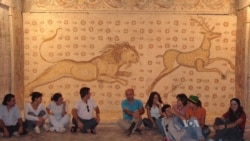The museum in the Syrian town of Maarat al-Numan is well-known for its ancient Roman and Byzantine mosaics — which are now hidden from view, indefinitely.
They were wrapped and sandbagged by volunteers who are working to preserve Syria’s history from the destruction caused by the country’s civil war.
Syrian opposition member Amr Al-Azm, an associate professor of history at Shawnee State University in Portsmouth, Ohio, said government forces launched an assault on Maarat al-Numan not long after the mosaics were sandbagged, and some mosaics were damaged in the process.
“It’s in territory controlled by the opposition, but the government regularly barrel-bombs it,” he said.
Al-Azm once served as director of Syria’s Science and Conservation Laboratories and taught at the University of Damascus. He fell out of favor with the Syrian regime and left the country before the civil war began. But his concern for Syria’s past, and its future, did not end when he left the country.
“We started to try to see if there was anything we could do to reduce the damage where possible, and more importantly, document what damage was already done,” he said.
From a computer at Shawnee State, Al-Azm coordinates preservation efforts with a network of colleagues and former students who remain in Syria. They are his eyes and ears on the ground, while he documents and compiles reports of the destruction, remotely.
The Maarat al-Numan museum is just one of thousands in the Middle East that archaeologists are concerned about. While the museum’s mosaics may have been saved from permanent destruction, many sites at risk are not easily accessible, including those in places controlled by Islamic State, where militants have already looted or destroyed important historic sites.
Sending a message
“These are carefully crafted atrocities," Al-Azm said, "and they send a very specific message that ISIS is here and it can act with impunity, and the fact that the international community is impotent to stop them.”
But ISIS isn't acting alone, said Professor McGuire Gibson, who specializes in Mesopotamian archaeology at the University of Chicago’s Oriental institute. "The looting that’s been taking place all over Syria is happening in areas where the various opposition groups are in control," he said.
Gibson said part of preserving Syria’s past is getting the international community to crack down on the trade of looted artifacts.
"Any site that archaeologists have worked on has been subjected to looting, because [thieves] know that there is something there that people will want,” he said.
Some pillaged items might never make their way back to Syria. Add them to what's already been destroyed, and Al-Azm acknowledges the Syria of the future may look very different.
“I hope that one day my children will be able to go back to Syria, and they’re not going to have the opportunity to see what I was able to see and grow up with,” he said.
That's why, despite the challenges of distance and access, Al-Azm and his network race to save what is left of Syria’s priceless, irreplaceable treasures.












